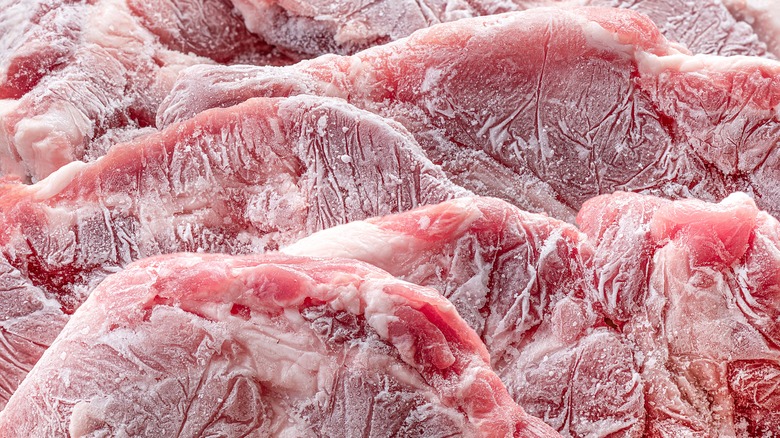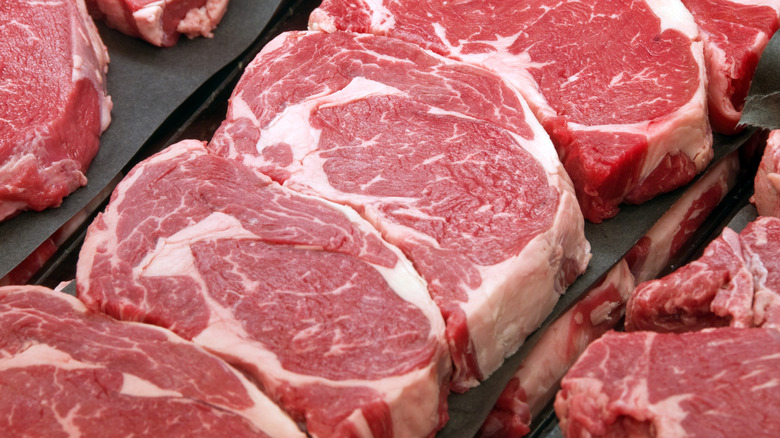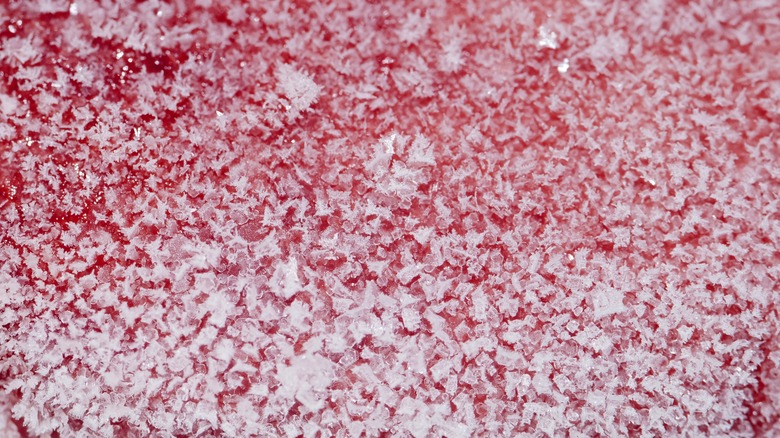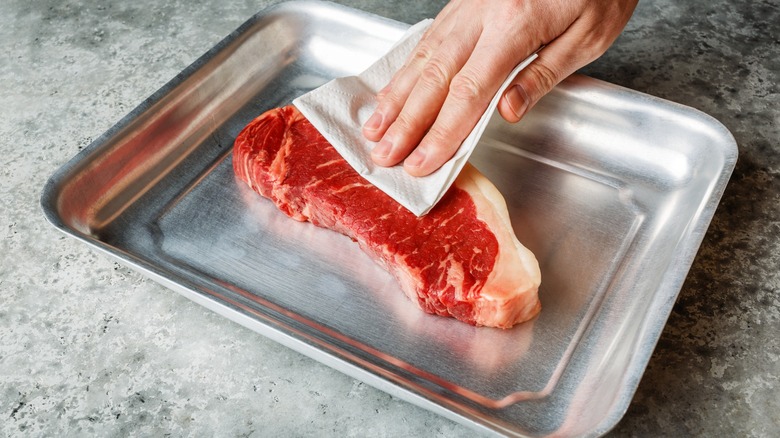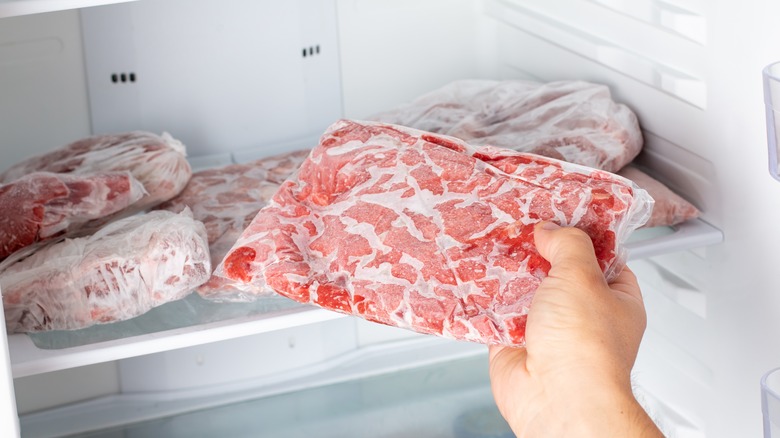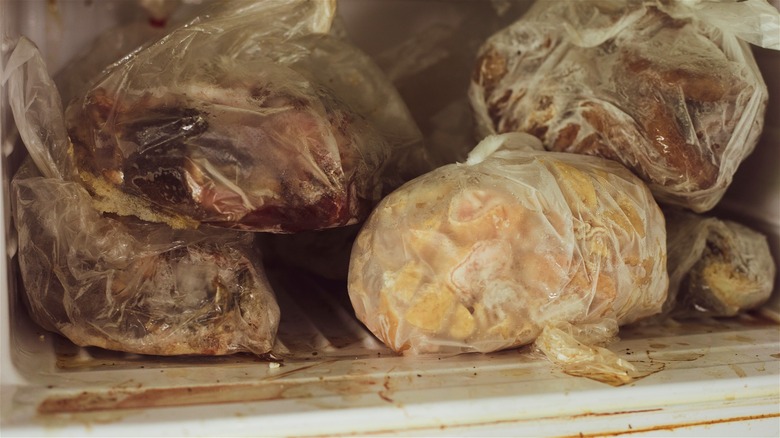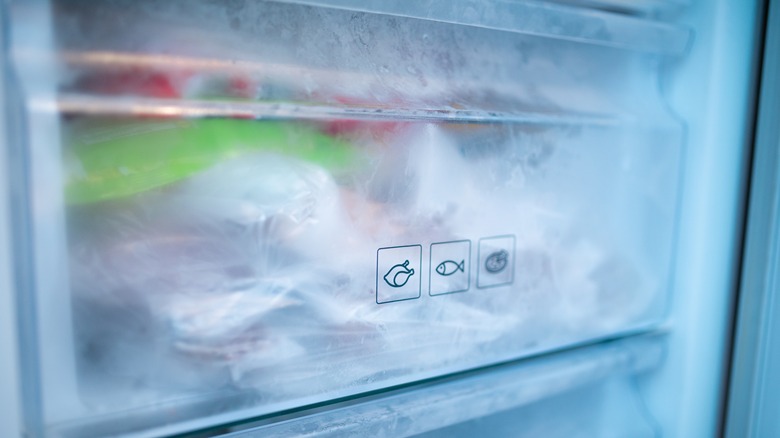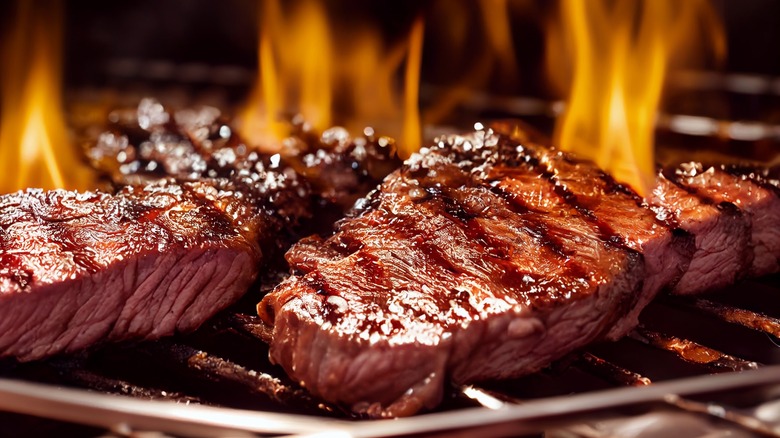8 Signs Your Frozen Steak Has Gone Bad
We're big fans of freezing raw meat as a time-saving move, and steak has to be one of our favorite items to stash away in the freezer. By buying in bulk and freezing individual portions, you can avoid buying pricey, individually-wrapped steaks, and instead enjoy your meat whenever you need it by pulling it out and thawing it. It can also stay fresh for up to a year when properly wrapped and stored, meaning that you can pull it out long after the purchase date and enjoy a quality piece of meat.
However, there are still potential food safety hurdles when it comes to frozen steak. Like all meat, steak is prone to deterioration. Although it should (in theory) remain safe to eat for a year — in a freezer kept at zero degrees Fahrenheit – appliance failure or thawing and refreezing steak can bring it up to a temperature where it can start to go bad.
When it does go bad, that steak can pose some serious health concerns. Eating frozen beef that's gone bad may result in infection from Salmonella or E. coli bacteria, producing unpleasant, potentially dangerous symptoms like diarrhea and vomiting (per Healthline). When steak has been frozen, though, it can be much harder to tell if it has gone bad. Luckily, there are a few key signs, which we've collected right here.
1. Its surface has changed color
If you're looking for a clue about your frozen steak's freshness, check its color. Gone-bad steak tends to have a way different color than fresh ones. Steak changes color when it starts to go bad due to oxidation. When this happens, the myoglobin in the meat alters in structure. That myoglobin, incidentally, is why you should stop calling your steak "bloody." The red juices that come out of a steak are actually myoglobin, not blood.
When a steak goes bad, it will lack the raw meat's usual red tones. Instead, frozen steak past its prime will darken in color, turning from red to a dull brown. If the meat looks greyer than usual or has a greenish tinge, you can be sure that the steak has become inedible and should be thrown out immediately. The older your meat gets, the more it will change color and become unsafe to eat. Using color to tell whether or not your steak has gone bad can be particularly useful when it's frozen, as smells and textures might be a bit harder to discern.
It's important to keep in mind, though, that some frozen beef steaks can also change color and still be okay to eat. They may naturally turn a darker tinge without necessarily going bad. If your meat has been stored correctly, was frozen when fresh, and doesn't smell off or feel tacky or slimy, it could still be safe to eat.
2. It starts to smell strange
A strange odor is a tell-tale sign that you should throw your steak out. When it starts to go bad, steak will develop an off-putting smell. This smell is usually compared to ammonia, and can also be slightly sulfuric. Whatever your nose is picking up, you should be able to tell pretty quickly that it's different from the regular smell of raw beef, which has a vaguely metallic, almost-sweet scent.
Importantly, the smell of an off steak may be less obvious when your steak is frozen. When food is frozen, there's less enzymatic and molecular activity — according to a 2010 study from Woodhead Publishing – which can therefore mean it generally has less of a smell when it's ice-cold (if you don't believe us, try comparing the smell of fresh loaves straight from the bakery to frozen slices of bread — you'll notice that the smell is dulled).
If you find that your steak has even a mildly off-putting scent, or if it starts to get a little stinky when it's thawed, you should throw it out immediately. You should also throw out any frozen, cooked steak that's developed a putrid smell or any other signs that it's past its best; remember that cooked meat can spoil, too.
3. Your steak develops ice crystals
You might think that ice crystals on a frozen steak are a natural part of the process — after all, if you're trying to freeze your meat, surely the presence of ice is a good thing, right? Not exactly. Ice crystals on your frozen steak are a sign that your meat's undergoing freezer burn, a process that causes your meat to deteriorate and lose its flavor and texture.
Freezer burn can occur when your food comes into contact with the frigid air of your freezer. Over time, this air (which is exceptionally dry) can start to dehydrate your food, sapping it of its moisture from its outer parts. This happens way more quickly and noticeably when food is packaged poorly, giving the air around it more access to its surface. As this happens, ice crystals form and your steak may develop a somewhat patchy appearance.
This process doesn't spoil your steak in the same way that microbial activity does, so it's technically safe to eat freezer-burnt meat. You might not enjoy it very much, though. Freezer-burned meat has a distinctive, freezer-like taste and its texture is usually pretty dry and tough, and especially fatty cuts of steak can begin to taste rancid. It's far better to throw freezer-burned steak out and start afresh.
4. Its texture looks or feels slimy
When establishing whether food has gone bad, your senses will be your best friend — and it's good to get your hands involved. This is because one of the most obvious signs of a gone-bad frozen steak is a change in its texture. Spoiled steak will often develop a tacky, slimy surface, which feels different from its regular, slightly moist surface. This sliminess is, somewhat disgustingly, a result of bacterial activity on the outside of your meat, which results in its spoilage. As such, if you end up thawing and cooking that steak, you'll be serving up a plate of bacteria. Pretty gross, right?
This bacterial activity is also what causes a gone-bad steak's unpleasant smell. Crucially, deterioration of steak is less likely to occur when it's frozen, as lower temperatures prevent this bacteria from growing and halt spoilage — and it may be harder to tell that a steak is slimy when it's frozen solid. However, spoilage can still occur in a freezer. If your appliance isn't set to a low enough temperature, for example, or you've frozen your meat after a machine malfunction, the bacteria could have ample time to grow and create a slimy, spoiled steak.
5. It's more than a year old
If you've got blocks of meat in your freezer older than your kids, you're not alone — it's all too easy to stash food away in there and then totally forget about it. However, if you've managed to excavate some old frozen steak from its lower chasms, you're probably better off throwing it away. Steak can stay fresh in the freezer for up to 12 months, but beyond that, it'll likely be inedible. While you can improve the odds of your steak staying good for longer by wrapping it securely or vacuum-sealing it, which will limit its access to the freezer air, anything more than a year will usually result in an unsatisfying meal.
If your steak has been kept consistently below zero degrees Fahrenheit, cuts that are older than a year may not have developed bacteria, so they won't necessarily be unsafe to eat. However, they'll likely be unsatisfying and won't taste the best. To keep track of when you freeze your food, it's always a good idea to clearly label it with both the date it was bought, and the date it was frozen. You should also try to frequently rotate stocks in your freezer, to make sure things are being used up regularly.
6. Your freezer has pink juice spills in it
An unclean freezer is unpleasant at the best of times, but in some cases, it could indicate spoilage. Spills or spots of pink or reddish juice could indicate that your freezer contains a steak that's gone bad. While it's tempting to assume that these spills are just blood that comes naturally from the meat, this isn't always the case. In some cases, these juice spots are something called purge. Purge is a sign of lost moisture from your steak. Purge is a sign that your meat is on the turn from good to bad.
If you have a noticeable amount of purge in your freezer (or in the container you froze your meat in), it could be a good idea to throw that steak away. To be sure that it's gone bad, you should try to see if other signs of spoilage are present on your steak too. Purge on its own may not mean that your steak is unsafe to eat, but purge accompanied by a foul smell or a change in color or texture puts it off-limits.
7. Your steak's surface is dry
Like many other foods, meat loses moisture over time, and this is especially likely to happen in colder environments like your freezer. So, if your steak is looking a little drier than you'd like after thawing it, it's probably best to throw it out. Freezer air is significantly drier than room-temperature or warm air, as its cold temperature means that it's less capable of holding moisture. This leads to the moisture in your foods, like steak, being wicked away into the freezer's environment and drying it out.
This effect is especially noticeable in a freezer, because the air is often constantly circulating, which helps keep its temperature consistent, but also brings more potential for water particles to be swept off. A dry, frozen steak may not mean that it's been subject to bacterial activity, but it may well mean that it's succumbed to freezer burn, ruining its flavor. Keeping your food in its original airtight packaging can help to reduce this, as well as inspecting your freezer seal to prevent frost from forming, which can then contribute to food drying out.
8. If you cook it, it tastes bad
So, your frozen steak has managed to evade detection up until the point of cooking. The final test, however, is its taste. Gone-bad steak will have none of that savory, intense meaty flavor that you normally expect from the meat, and instead will have a rancid, slightly sickly taste. Bad steak may also have some more acidic flavors lurking inside it, and it will leave you with a foul aftertaste that'll have you reaching for a glass of water (or a sick bucket) and ruining your grilled steak dinner. This taste will usually be accompanied by an equally bad texture, which will also be pretty gross and overly mushy.
It's crucial to keep in mind that if you freeze your steak when it has already gone bad, it won't magically become better when you cook it. Freezing food doesn't kill bacteria. Instead, it just pauses its activity until it's at a temperature where it can thrive again. While cooking it at a high heat may kill it off, if your steak has turned bad there's little you can do to salvage its taste and texture.
